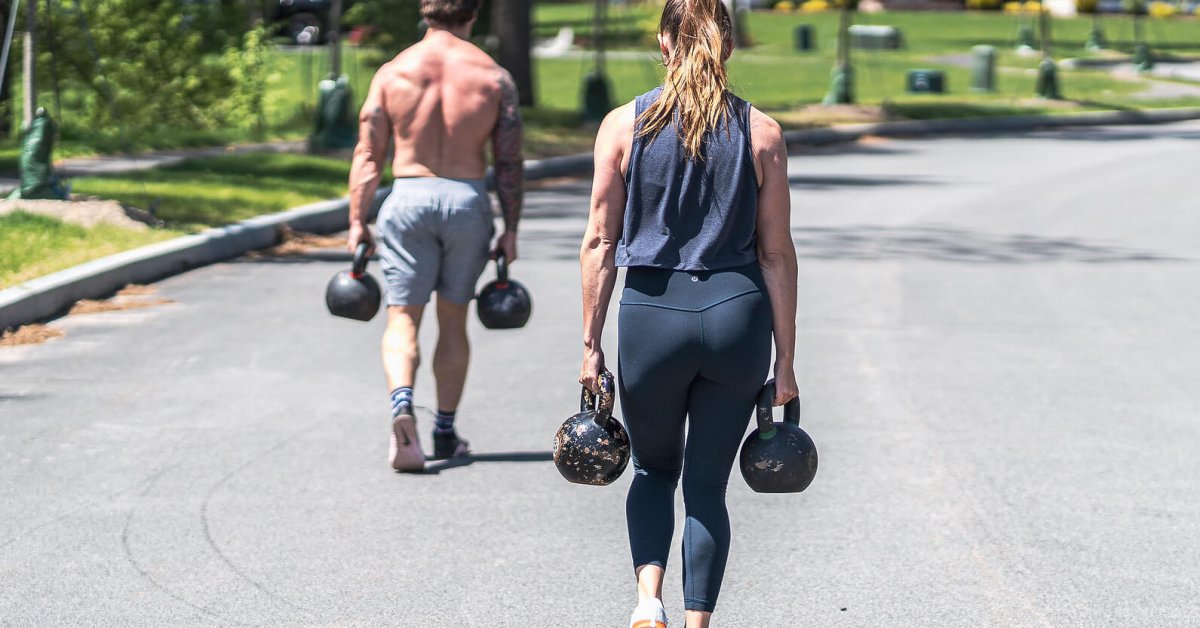It’s no mystery that loaded carries have a multitude of uses. The fact that we are able to effectively check off multiple boxes in terms of benefits is an added bonus.
We know that loaded carries can help us to develop stability in all three planes of motion, but we often don’t consider the value from a conditioning standpoint.
On top of being a foundational movement pattern (local motion), loaded carries can improve the aerobic abilities of the fast-twitch fibers, which means high power can be maintained longer.
Loaded carries work by recruiting high-threshold motor units and increases the oxidative abilities of these fibers by supplying them with constant oxygen.
We can use a variety of loaded carries that will fit the bill to help you develop core stability; from a maximal heart-rate perspective, performing sets of loaded carries will allow us to hover right on the anaerobic threshold line.
If you don’t believe me grab a set of heavy kettlebells and walk for 20 seconds. You’ll be pretty winded, but not in the sense that you’re not able to repeat this effort for multiple bouts.
It’s also important to note that competitive CrossFitters are constantly asked to lock weight out isometrically in a variety of tasks (handstand walking & overhead loaded carry variations) – loaded carries are a great means of improving those tasks.
Here’s what you need to know:
- These loaded carries can be used in both strength & conditioning scenarios – the former will be used for shorter distances with heavier loads and the latter will be used for longer distances with lighter loads.
- You can constantly change how these are performed by adding things like a pulling sled to the mix
- Longer distance carries should be done on a conditioning day whereas as heavier work can be done as a “finisher” on a strength-emphasis day
- Use your imagination and “gamify” these finishers – 1/2 mile farmer carry for time is an example.
#10 Single Arm Farmer Carry
It’s hard to NOT include the single-arm farmer carry since it offers us the ability to train the frontal core, quadratus lumborum, and the aerobic system. Perform sets that last around 20s with the heaviest weight you can handle, alternating between both sides evenly.
Rest roughly 90s or until your heart rate is around 130-140. The single-arm carries will get your heart rate up and also develop frontal core stability.
#9 Front Rack Carry
Grab two kettlebells and place them in the front rack position. Your elbows should be in front, not flared out, and your ribs should be down/anterior core engaged.
Same guidelines as above; perform sets that last around 20s with the heaviest weight you can handle. Rest roughly 90s or until your heart rate is around 130-140.
#8 Crossbody Carry
With this variation, you’ll carry two kettlebells; one heavy and one lighter. You’ll hold one by your side (heavier kettlebell) and one in the Front Rack.
You’ll carry an equal distance on each side using the same guidelines as the 1st two categories we mentioned.
#7 Sledpull with heavy medball against your stomach
For this variation, you’ll attach a light sled to your weight belt and grab a heavy medball (50#s or more). Make sure you start light with this one. This variation will likely get your heart rate up a lot higher than the first two variations, so the training recommendations are going to differ.
You’ll want to perform 4 sets of 60 yards, resting 2 minutes between sets or for distances up to 800 meters.
You can alter the positioning of the medball as well as throughout your sets – against stomach, high on the chest, or low on the hips.
#6 Sledpull with two light kettlebells
For this variation, you’ll want to use the sled the same way you did for #4, except this time you’ll use two light kettlebells. For this variation, you’re going to go for max distance in 10 minutes, alternating between overhead carry, front rack carry, and farmer carry.
You can rest as much as you need to between intervals in order to repeat your output for the duration. This can be used as a “fun” finisher after just about any training session.
#5 Heavy medball carry against the stomach
If you have access to heavy medballs (at least 100 lbs) or stones this is a great variation to challenge your breathing ability not to mention is quite demanding on both the anterior and posterior chain.
Sets of 40-60 yards are that all that’s needed or going for longer distances with a lighter medball is another option for those that are looking to improve aerobic function.
#4 Front Rack + Overhead Carry
I love this variation for CrossFitters that are looking to improve higher-skill components such as overhead isometric strength with things like handstands all while trying to maintain anterior core integrity – critical to a successful CrossFitter.
Sets of 20-40 yards per side fit the bill. Or for an added strength-endurance challenge use light kettlebells, attach a pulling sled to your waist, and go for 400 meters stopping as few times as possible.
#3 Trap Bar Farmer Carry
The trap bar allows us to load the farmer’s carry to really test our grip capacity. Here are a few challenges for you I learned from Dr. John Rusin:
- Rx+: 30 seconds with 200% of Bodyweight
- Rx: 30 seconds with 150% Bodyweight
- L3: 30 seconds with 100% of Bodyweight
#2 Double Kettlebell Overhead Carry
A staple for CF Competitors which a huge carryover to things like overhead walking lunges variations and handstand walking. This particular variation can be done in a number of ways (with a barbell or bamboo bar) for an increased level of difficulty, but I prefer the kettlebells for simplicity and the unilateral component. Kettlebells also tend to be more user-friendly for variations like this vs. a standard set of dumbbells.
For strength work perform 4-5 rounds of 90 ft. Rest 60-90s between rounds. For strength-endurance work – 400 meters for time.
We also favor using these in a mixed-modality setting regularly similar to what a CF competitor could see in competition with a variety of moving parts.
#1 Zercher Yoke Carry
This is one of the most brutal loaded carry and definitely not for the novice trainee. Of course, you’ll need to have access to a yoke to perform these, but if you do NOT a barbell will do the job – I’d recommend wearing knee sleeves on your arms though as the barbell is less forgiving than the yoke.
The Zercher yoke carry presents challenges to all three energy systems as well as core control. This is a variation we program often for our CF competitors as they can be faced with challenges much like this in any given competition.
You’ll want to perform these for smaller sets. Shoot for 5-6 rounds of 50 ft resting 90s – 2:00 between rounds.
Closing
Loaded carries are so effective that you won’t find one program that we offer that does not include them on the regular.
Adding these loaded carries to your repertoire and you’ll notice the carryover to other aspects of your performance almost right away, especially if you don’t already perform loaded carries on the regular.
Loaded carries are in an integral part of any intelligent training plan so make sure to devote some time to include them in your programming. There is a long list of variations too so don’t just perform the same variations each week. Get creative and have fun with it!


